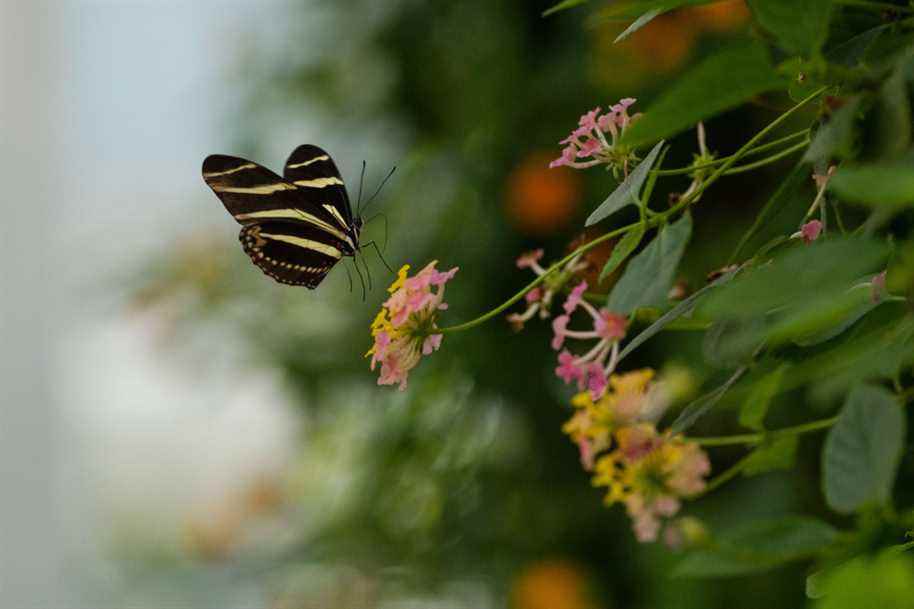Posted at 11:30 a.m.
Underground

PHOTO PROVIDED BY THE INSECTARIUM
The visit to the museum begins in a dark corridor.
The dark corridor contrasts with the large room bathed in sunlight which welcomes visitors to the Insectarium. It takes some time for the eyes to get used to the half-light of this winding path and these alcoves imagined to plunge humans into the life of a beast. Like a worker ant, we walk through these underground galleries with earthy-looking walls.
How do insects see and hear? A screen, a metal floor and ultraviolet lamps offer a glimpse of the answer.
Along the course, we are invited to move like these little creatures. Flavie, a 4-year-old bugger, particularly enjoyed jumping from twig to twig and crawling through the tunnels. We also fell in love with the installation which allows you to walk on the ceiling like a fly.
This multisensory immersion in the life of an insect is very entertaining. We would have liked it to continue for the time of a few additional experiments.
In the dome
-

PHOTO HUGO-SÉBASTIEN AUBERT, THE PRESS
Present at the inauguration of the Insectarium, the Mayor of Montreal, Valérie Plante, observes the collection of stuffed insects.
-

PHOTO HUGO-SÉBASTIEN AUBERT, THE PRESS
Some 3,000 specimens are displayed on the walls of the dome.
-

PHOTO HUGO-SÉBASTIEN AUBERT, THE PRESS
Some insects have been classified by color.
1/3
Next step: meeting the first living specimens. With their semi-circular shape, the vivariums offer the visitor seated on a stool a one-on-one with various species. Among them, some are past masters in the art of camouflage. Can you find the orchid mantis, so easy to confuse with a flower?
A few steps further, we enter the dome, a large circular space where we find some 3000 stuffed insect specimens. The Insectarium collection has been 80% renewed for this reopening.
Each of the 72 showcases looks like a work of art, especially those classified according to a chromatic arrangement. Too bad the upper windows are not accessible to the eyes of young children. Parents, prepare your shoulders or your arms, they will certainly be requisitioned by the little ones.
They will also want to know the name of this blue butterfly or even to know which region this large stick insect, nicknamed “insect-branch”, comes from. Don’t know the answer? Turn to one of the Insectarium’s scientific facilitators, such as Thierry Bergeron, or download the mobile application space for life. “In the application, we have a photo of the window and a short description. There are some insects that are more documented, but, for the most part, there is going to be the Latin name and where it comes from,” he explains. Tablets can also be consulted on site.
On the surface
-

PHOTO HUGO-SÉBASTIEN AUBERT, THE PRESS
In the large vivarium, visitors live alongside insects.
-

PHOTO HUGO-SÉBASTIEN AUBERT, THE PRESS
There are about 1500 butterflies in the greenhouse.
-

PHOTO HUGO-SÉBASTIEN AUBERT, THE PRESS
You will see different species there, depending on the time of year.
-

PHOTO HUGO-SÉBASTIEN AUBERT, THE PRESS
New butterflies are added to the vivarium every day.
1/4
We then emerge from the basement to enter the large vivarium. Some 1,500 butterflies flutter about in this magnificent greenhouse with an almost tropical climate. Fans of the “Butterflies Go Free” activity will now be able to see them fly all year round.
But butterflies are not alone. Other living insects, for example leafcutter ants, are active among the 3000 plants in the greenhouse.
When passing from The Press, the butterflies were very active, foraging from flower to flower or feeding by stopping on slices of orange laid out for them. A magnificent spectacle of nature in front of which we marvel.

PHOTO HUGO-SÉBASTIEN AUBERT, THE PRESS
The front of the Insectarium is entirely glazed.
Arousing emotions in visitors to bring them to transform their relationship with insects is also one of the objectives pursued by the museum. “The metamorphosis of the Insectarium is also the metamorphosis of the visitor. It is a reframing of the visitor’s relationship with insects to bring him into a posture of humility, respect and appreciation of insects, ”explained Maxim Larrivee, director of the Insectarium, at a press conference on Tuesday. Highlighting the essential role of insects in our ecosystems, he said he hopes visitors will want to “live more in harmony and in harmony with nature”.
Leaving the museum, we also realize that we will no longer look at these little creatures in the same way.
Learn more
-
- $38.4 million
- Cost of the Insectarium makeover project
Source: Montreal Insectarium
-
- 40%
- The new Insectarium is 40% larger than the old one. Already awarded, the architectural concept of the museum, inspired by insects, is the result of an international architectural competition.
Source: Montreal Insectarium
-
- 3
- Initially planned for two years, the work stretched out over three years. The pandemic and the shortage of building materials are responsible for the delays, reported The Press in January.

